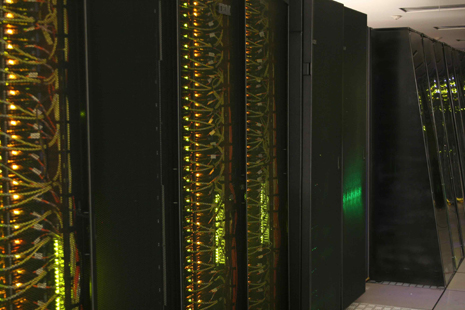
FAYETTEVILLE, Ark. – The University of Arkansas’s newest computing resource, called Razor, is enabling researchers to solve large problems faster than ever.
“We more than doubled our resources when we added Razor,” explained Amy Apon, professor of computer science and computer engineering and director of the Arkansas High Performance Computing Center.
Currently, faculty and students from several departments at the University of Arkansas are using the high-performance computers to explore the fundamental properties of chemicals and nanomaterials, develop new methods of detecting breast cancer and organize large sets of spatial data.
The high-performance computers can be accessed by any faculty member or student at the University of Arkansas, and by the faculty and students from other Arkansas universities that are members of the Arkansas Research and Educational Optical Network. Apon explained that programming skills are helpful, but not necessary for using the supercomputers.
“We have users from across campus who aren’t skilled programmers, but they have some applications that they run,” Apon said. “They can prepare a data set and instructions to the program about how to process the data set and then run it without having to have a lot of programming skills. We have three full time staff who work to keep the system up and running and help users. It’s actually amazing how much help we’re able to provide.”
Razor features 126 dual hex-core processors for a total of 1,512 processing cores running at 2.93 GHz. Its memory is measured in billions and trillions of bytes: 2 gigabytes of memory per core and more than 200 terabytes of disk storage. The processing speed of Razor is 17.75 trillion floating-point operations per second, or teraflops.
Combined with the university’s other supercomputer, the Star of Arkansas, and six additional GPU nodes, the addition of Razor brings the university’s total capability to more than 34 teraflops. This allows researchers to solve complex problems that require many calculations at one time.
In addition to using Razor, researchers can purchase high performance computing hardware that is co-located with Razor but set aside for their exclusive use any time the university makes a new acquisition. Researchers interested in this should contact the Arkansas High Performance Computing Center.
The Arkansas High Performance Computing Center is funded by grants from the National Science Foundation and the Arkansas Science and Technology Authority. For more information, visit hpc.uark.edu.
Contacts
Amy Apon, director of the High Performance Computing Center
College of Engineering
479-575-6794, aapon@uark.edu
Camilla Medders, director of communications
College of Engineering
479-575-5697, camillam@uark.edu